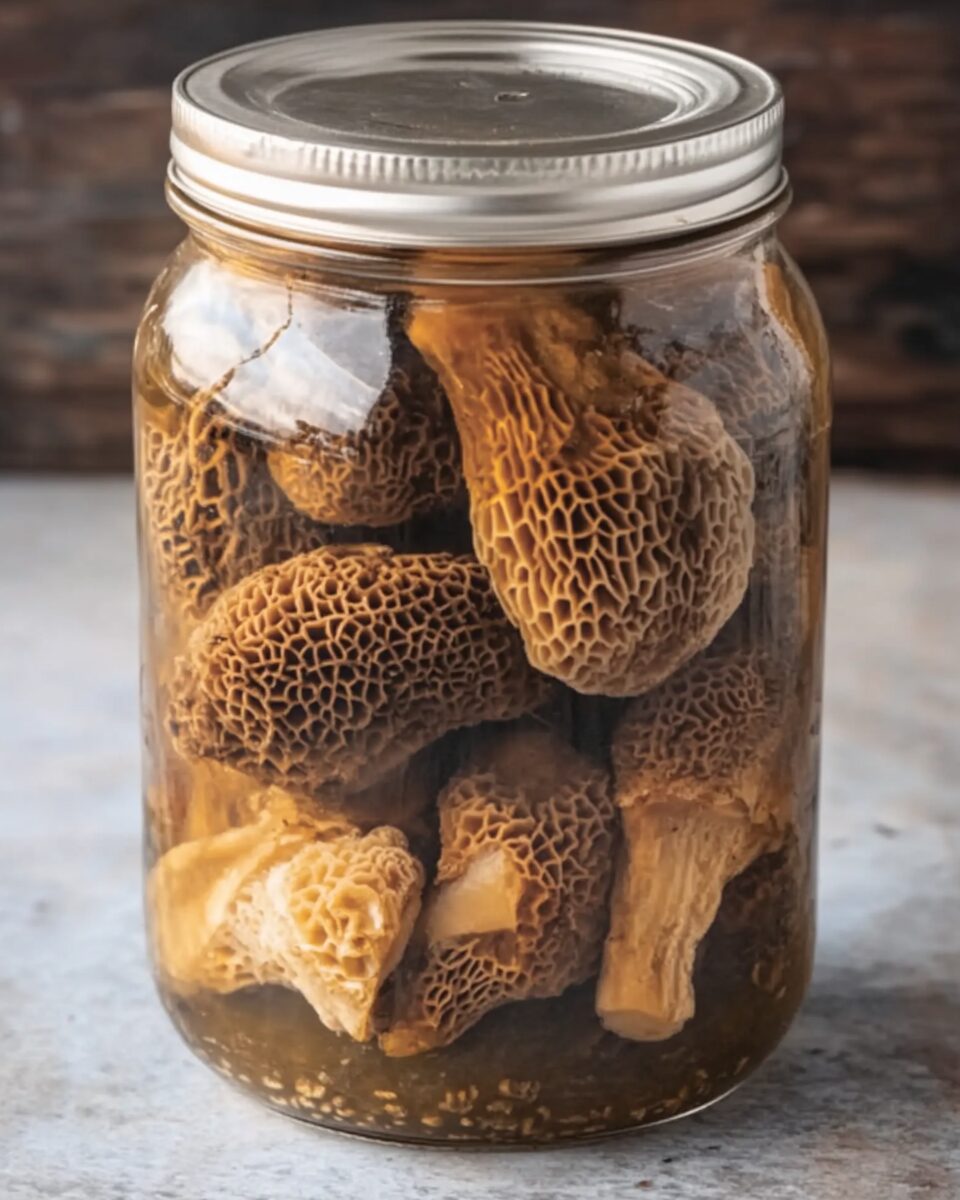These Pickled Morels are a flavorful homage to ancient Roman cuisine, where fermentation and preservation were essential to everyday life. Using wild morel mushrooms and a blend of vinegar, honey, and herbs, this recipe bridges the old world with modern culinary sensibilities. The earthy mushrooms soak up the complex brine, transforming into a bright, tangy treat that pairs perfectly with cheese, charcuterie, or roasted meats. This dish is not only a way to preserve your seasonal mushroom harvest but also a conversation-starting delicacy that brings elegance to your table. Ideal for springtime foraging lovers or food history enthusiasts, these pickled morels are surprisingly simple to make and endlessly versatile. Try them once and you’ll never want to let morel season pass without a jar or two on hand.
Full Recipe:
Ingredients:
-
1 pint fresh morel mushrooms, cleaned and halved lengthwise
-
1 cup white wine vinegar
-
1/2 cup water
-
2 tablespoons honey
-
1 teaspoon sea salt
-
1/2 teaspoon black peppercorns
-
1 teaspoon mustard seeds
-
2 cloves garlic, crushed
-
2 sprigs fresh thyme
-
1 bay leaf
-
Optional: 1 small dried chili for a touch of heat
Directions:
-
Gently clean morels by brushing off dirt and slicing them in half lengthwise to check for any debris inside. Do not soak in water.
-
Bring a pot of water to a boil, blanch morels for 2 minutes, then immediately plunge into an ice bath. Drain and set aside.
-
In a saucepan, combine vinegar, water, honey, salt, peppercorns, mustard seeds, garlic, thyme, bay leaf, and chili if using. Bring to a boil, then reduce to a simmer for 5 minutes.
-
Add blanched morels to the hot pickling liquid and simmer for 2 more minutes.
-
Transfer the mushrooms and liquid into sterilized jars, making sure morels are fully submerged.
-
Let cool to room temperature, seal, and refrigerate for at least 24 hours before eating.
-
Best enjoyed within 2 weeks, served as an antipasto, with cheese, or alongside grilled meats.
Prep Time: 10 minutes | Cooking Time: 10 minutes | Total Time: 20 minutes
Kcal: 80 kcal | Servings: 4 small appetizer servings
A Taste of Ancient Rome in a Modern Kitchen
Pickling is one of the most ancient and cherished preservation methods in the culinary world. For foragers and chefs alike, wild morel mushrooms those honeycombed, elusive treasures of spring offer a chance to connect deeply with the forest, the seasons, and our ancestral roots. Pickling morels elevates this experience even further, transforming a fragile and perishable delicacy into a tangy, savory condiment that pays tribute to the food culture of ancient Rome while finding its place at modern tables.
Morels are among the most coveted of wild mushrooms, prized not just for their earthy, nutty flavor but for their scarcity and short season. By pickling them, we extend their lifespan far beyond the fleeting weeks of spring. But this recipe isn’t just about utility it’s a culinary bridge between time periods, cultures, and cooking philosophies.
The Cultural Significance of Pickling
Pickling was a crucial practice in ancient Rome, long before refrigeration or canning existed. Romans preserved vegetables, fruits, and even fish in vinegar or brine to ensure availability through the winter months and during long travels. Historical records, like those from the Roman gourmet Apicius, describe the use of vinegar and honey as common preservatives for both flavor and function.
What’s fascinating about Roman pickling methods is their balance of acidity and sweetness. Unlike modern pickles that lean heavily into sharp vinegar flavors, Roman recipes often used honey to mellow and round out the bite. This nuanced approach is evident in our recipe, where vinegar and honey blend into a bright, complex brine that enhances not overpowers the delicate flavor of morels.
Morels: The Forager’s Gold
Morels (genus Morchella) are more than just another wild mushroom. They’re the stuff of culinary legend, hunted each spring in forests across North America and Europe. Their honeycomb-like caps and hollow interiors are easily recognizable to seasoned foragers, but still require careful cleaning and handling due to their fragility.
The morel’s flavor is unique: rich, woodsy, and almost meaty, with umami depth that makes it a favorite of chefs and gourmands alike. Unlike cultivated mushrooms like button or portobello, morels cannot be reliably farmed. This wild nature makes them all the more special, connecting cooks to the land in a meaningful, seasonal ritual.
Why Pickle Morels?
Morels are delicate and highly perishable. Once picked, they spoil quickly sometimes within a few days. While drying is one preservation method, pickling offers a completely different experience. It adds acidity and brightness to the mushroom’s natural flavor and brings in a complexity that dried or sautéed preparations can’t provide.
Pickled morels are also incredibly versatile. Their briny tang and subtle spice pair well with a wide range of foods:
-
Charcuterie boards – alongside cured meats, cheeses, olives, and mustards.
-
Sandwiches and burgers – for a gourmet upgrade.
-
Grilled meats – especially lamb, pork, or game.
-
Salads – chopped or sliced thin for a pop of umami.
-
Tartines or toasts – with soft cheese and herbs.
-
Cocktail garnishes – a unique alternative to olives or onions in martinis or Bloody Marys.
The honey and vinegar in the brine give the mushrooms a sweet-sour profile, while aromatics like thyme, garlic, mustard seeds, and black peppercorns echo ancient Mediterranean flavors.
A Nod to Ancient Techniques
This pickling method leans on simple, pantry-friendly ingredients, much like the Roman approach. The use of honey is especially important it replaces processed sugar with a natural sweetener that’s been used for thousands of years. In Roman cuisine, honey was more than a sweetener; it was medicinal, symbolic, and practical.
The brine here is gently simmered with herbs and spices, not boiled to oblivion, to preserve the brightness and clarity of flavor. This slow, deliberate technique allows each component vinegar, honey, garlic, thyme, bay leaf to infuse the mushrooms without overshadowing them.
Even the blanching step mirrors ancient preservation logic: a quick boil and chill that tightens the mushrooms’ structure and prevents them from becoming overly soft or mushy in the brine. The result is a perfectly textured pickle with bite, chew, and vibrant flavor.
Storage and Shelf Life
Since this is a quick pickle not a fermented or water-bath canned version the pickled morels should be kept in the refrigerator. They’re best enjoyed within 1 to 2 weeks for optimal texture and brightness, though they may keep longer if stored properly and consistently chilled.
The jar may develop a more intense flavor over time as the ingredients continue to mingle. If you’re planning to gift jars to friends or family, be sure to label them with a “consume by” date and storage instructions.
For longer-term preservation, consider processing the jars in a boiling water bath for 10 minutes (adjusting for altitude), but note that heat can slightly soften the mushrooms and alter the texture.
Creative Variations and Pairings
Though the base recipe is rooted in Roman tradition, it’s endlessly customizable. Here are a few twists to try once you’ve made the original:
-
Add citrus zest (like lemon or orange) for brightness.
-
Swap white wine vinegar for apple cider vinegar for a fruitier tang.
-
Include fennel seeds or coriander for added aromatic complexity.
-
Try maple syrup in place of honey for a woodsy, North American twist.
-
Toss with roasted vegetables and grains like farro or bulgur for a hearty salad.
You can even use the leftover brine as a vinaigrette base just whisk in olive oil for a tangy salad dressing that carries a whisper of forest floor and wild herbs.
A Culinary Time Capsule
What makes this recipe special isn’t just its flavor it’s the historical connection it creates. In a single bite of pickled morel, you taste the forest in springtime, the wisdom of ancient preservation techniques, and the modern creativity that bridges centuries of food culture. It’s a dish that invites us to slow down, savor, and appreciate the wild ingredients and traditional methods that have fed humans for generations.
Conclusion:
Pickled morels are more than a seasonal snack they’re an invitation to engage with your food on a deeper level. Whether you forage your own or buy them from a local market, preparing them using this Roman-inspired method brings together nature, history, and flavor in a way few dishes can.
In preserving your morels with honey and vinegar, you’re not just extending their shelf life you’re honoring centuries of culinary wisdom and transforming a short-lived ingredient into a lasting memory. Enjoy them with friends, gift a jar to a fellow food lover, or simply savor them solo with a glass of wine. However you serve them, one thing’s for sure: these pickled morels will become a treasured part of your spring ritual.

